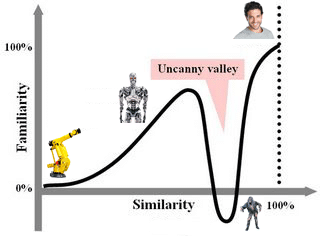English
The Uncanny Valley Of Fluency: For Advanced Learners Only
To sound like a native English speaker, you must understand the Uncanny Valley of Fluency…
I think The Uncanny Valley of Fluency explains a lot of the frustration advanced learners feel as they get closer to fluency.
The uncanny valley suggests that as objects look more and more human, they reach a point where they look almost human, but not quite…
Observers feel uncomfortable feelings of eeriness and revulsion as a result.
It’s the Uncanny Valley

In the chart above, a Terminator robot feels more human than a factory robot arm.
When we look at a zombie (at the bottom of the chart on the left), we fall into the uncanny valley.
The exact same thing happens in conversations when native speakers converse with learners at different levels of fluency.
It’s not odd or surprising for a native English speaker to meet someone who doesn’t understand English.
Intermediate speakers make mistakes despite knowing many words and phrases.
Native English speakers understand that English learners at this level know a lot, but still have a long way to go.
When native speakers listen to advanced learners who almost speak perfectly, a problem arises…
Often, these speakers use native phrases, but they’re incorrect by a single word.
Their pronunciation is nearly native, but there are a few sounds they just can’t get right.
It is almost possible to mistake these learners for natives.
As natives hear this “almost native” speech, they become disconnected mentally from the student for a moment, realizing they are speaking with a non-native.
The Uncanny Valley of Fluency is what I call it.
However, this does not mean native speakers aren’t impressed by advanced speech, or that they actually feel uncomfortable when advanced learners make tiny mistakes…
In fact, they are!
However, learners at this level are viewed differently, almost like robots.
Although you might be amazed by a robot that looks almost human, it’s never completely convincing.
Check out the almost native speech in the following paragraph:
“I’m taking dance lessons these days, but I don’t seem to be getting anywhere. I’m an optimistic person, though. If I keep going, I’m sure I’ll succeed.”
It’s usually excellent speech that a native can understand.
It’s also slightly “off,” a native expression meaning “weird” or “different,” which leaves the student in The Uncanny Valley of Fluency.
A native would say:
Currently, I’m taking dancing lessons. I’ve asked my instructor for advice, but I don’t seem to be progressing. I’m optimistic, though. If I keep going, I’m sure to succeed.”
There’s nothing “wrong” with this level of English. And these mistakes are usually very small…
This kind of speech can make learners feel “so close, yet so far away” from taking their English to the NATIVE level – and this is certainly possible.
When a native speaker notices one of these tiny errors, advanced learners get frustrated.
You can actually reach the level where people can’t tell if you’re native or not, unlike video game characters and robots that never look real enough.
It is truly the highest compliment a language learner can receive when they discover someone isn’t native.
WOW! You’re NOT from (some English-speaking country)? You speak English like a native!”
Just knowing some useful words and phrases for everyday conversation makes many students happy…
For those who wish to cross the Uncanny Valley of Fluency, they must learn how natives speak, and then practice until everything becomes automatic.
With our premium programs like The Fluency Course, we help people achieve this goal.
It doesn’t matter whether you learn with me or not, remember that you CAN learn how to speak English fluently and like a native! 🙂
Drew
Your English Fluency Guide


